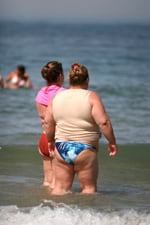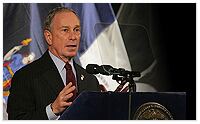An analysis of dietary intake data from the National Health and Nutrition Examination Surveys (NHANES) published in the American Journal of Clinical Nutrition shows that the energy Americans aged 2-19 derive from sugar-sweetened beverages* dropped from an average of 223 calories a day in 1999/2000 to 155 calories a day in 2009/2010.
As a percentage of overall energy intakes this represents a drop from 10.9% of daily calories to 8% of calories.
A similar pattern is evident among adults (20+ years), whose energy intakes from sugar-sweetened dropped from 196 calories a day in 1999/2000 to 151 calories a day in 2009/10, with the biggest shift also kicking in during the middle of the decade.
As a percentage of overall energy intakes this represents a drop from 8.7% of daily calories to 6.9% of calories.
Sports & energy drinks contributed an average 12 calories a day for 2-19 year olds in 2009/10.
The study, which was based on a large sample (22,367 children and adolescents aged 2-19 years and 29,133 adults aged 20+ years), also provides an interesting snapshot of how beverage consumption patterns have changed - with a steady drop in liquid milk consumption (click here) coinciding with growth in sports and energy drinks, tea and coffee.
Meanwhile, fruit drink consumption dropped across all age groups, with 2-19 year-olds typically consuming 16 fewer calories per day from these drinks in 2009/10 vs 1999/2000.
By contrast, consumption of sports and energy drinks increased over the 12-year period, although they only accounted for 12 calories a day for youth and 10 cals/day for adults in 2009/10.
Interestingly, while energy intake from sugar-sweetened beverages decreased over the 12-year study period for those aged 20–39 and over 60, it stayed around the same for adults aged 40–59.
Boys aged 12-19 consume 278 calories a day from sugar sweetened beverages

Despite the declining overall trend, however, the energy contribution that sugar-sweetened beverages make to the American diet remains considerable, note the authors.
“Despite this decreasing trend, on average, American youth and adults consumed 155 and 151 kcal a day respectively from SSBs in 2009–2010, which equates to slightly more than one 12-fluid oz (355-mL) can of cola.”
And given that some people consume no sugar-sweetened beverages at all, this means that other groups are still consuming a large number of calories from soda.
Within the NHANES data, boys aged 12-19 years are the highest consumers, taking in an average of 278 calories a day from sugar sweetened beverages (whereas for girls the same age the figure is 175 calories).
To put this into perspective, the Dietary Guidelines for Americans suggest that boys aged 14-18 with a sedentary lifestyle need 2000-2400 cals a day, so for this group, 278 calories represents between 11.6% to 14% of daily energy needs.
Nearly half of teenagers do not drink milk
According to an analysis of NHANES data unveiled at the Food & Nutrition Conference & Expo (FNCE) in Philadelphia last fall by the Dairy Research Institute, the biggest changes in soda consumption started to show up in the 2005/6 data. Click here.
Indeed, the percentage of 6-12-year-old kids drinking soda had been rising from 1976 to 2006 but then started to turn around in the 2007-2010 period, a factor some observers claim could explain why the growth rates in childhood obesity have started to level off in recent years.
However, the biggest story to emerge from the statistics was the steady drop in milk consumption, claimed director of regulatory affairs, Dr Erin Quann.
For example, the percentage of children that drink milk aged 6-12 fell from almost 90% in 1976-80 to around 73% in 2007-10 while among 13-17 year-olds it fell even more sharply, from just over 75% in 1976-80 to just 57% in 2007-10, she said.
“We’re seeing a steady sharp decline in school age milk drinkers and nearly half of teenagers do not drink milk.”
ABA: The New York City Health Department is oversimplifying the complex set of factors behind obesity

The data was published as the New York City Health Department upped the ante in the debate over sugary drinks and obesity with new ads featuring patients with amputated toes and diseased hearts to raise awareness about the sugar content of fruit juices, sweet teas, sports and energy drinks.
The ads - which were dismissed by the American Beverage Association (ABA) as “over the top” and “misleading” - urge New Yorkers to swap sugary drinks for water, unsweetened tea or fresh fruit, and comes as the ABA and the city's administration prepare to head back to court over Mayor Bloomberg’s proposed ban on super-size sodas.
The city appealed New York Supreme Court Justice Milton Tingling’s decision to overturn the ban the day before it was due to come into effect in March (click here), and will present oral arguments next Tuesday (June 11) along with lawyers for the beverage industry.
"Once again, the New York City Health Department is oversimplifying the complex set of factors behind obesity,” ABA spokesman Chris Gindlesperger told FoodNavigator-USA yesterday.
Asked why the ABA felt the ads were unreasonable given that they were mirroring the Dietary Guidelines for Americans - which also advise consumers to swap sugary drinks for less caloric alternatives - he said sugary drinks were being unfairly singled out:
“Obesity is caused by an imbalance of calories in and calories out, and calories can come from a wide variety of sources.”
NYC ads is just the latest example of the city's attempt to demonize yet another product that is safely consumed by millions of people a day
The new ads (click here), which run on buses and TV, explain that sports/energy drinks and some juice drinks may ‘sound healthy’ but are loaded with added sugars that lead to obesity, type 2 diabetes and heart disease.
J. Justin Wilson, senior research analyst at the Center for Consumer Freedom, which critics claim is heavily funded by the food and beverage industry, said: “The Department of Health's advertisement is just the latest example of the city's attempt to demonize yet another product that is safely consumed by millions of people a day.”
* Sugar-sweetened beverages include soda, fruit drinks, sports and energy drinks, sweetened coffee and tea, and other calorically sweetened beverages, but excludes 100% juice, alcohol and drinks to which consumers add sugar after purchase.
Source: American Journal of Clinical Nutrition
Published online ahead of print, May 15, 2013 ‘Trends in sugar-sweetened beverage consumption among youth and adults in the United States: 1999–2010 ‘ Am J Clin Nutr 2013 ajcn.057943
Authors: Brian K Kit, Tala HI Fakhouri, Sohyun Park, Samara Joy Nielsen, and Cynthia L Ogden
